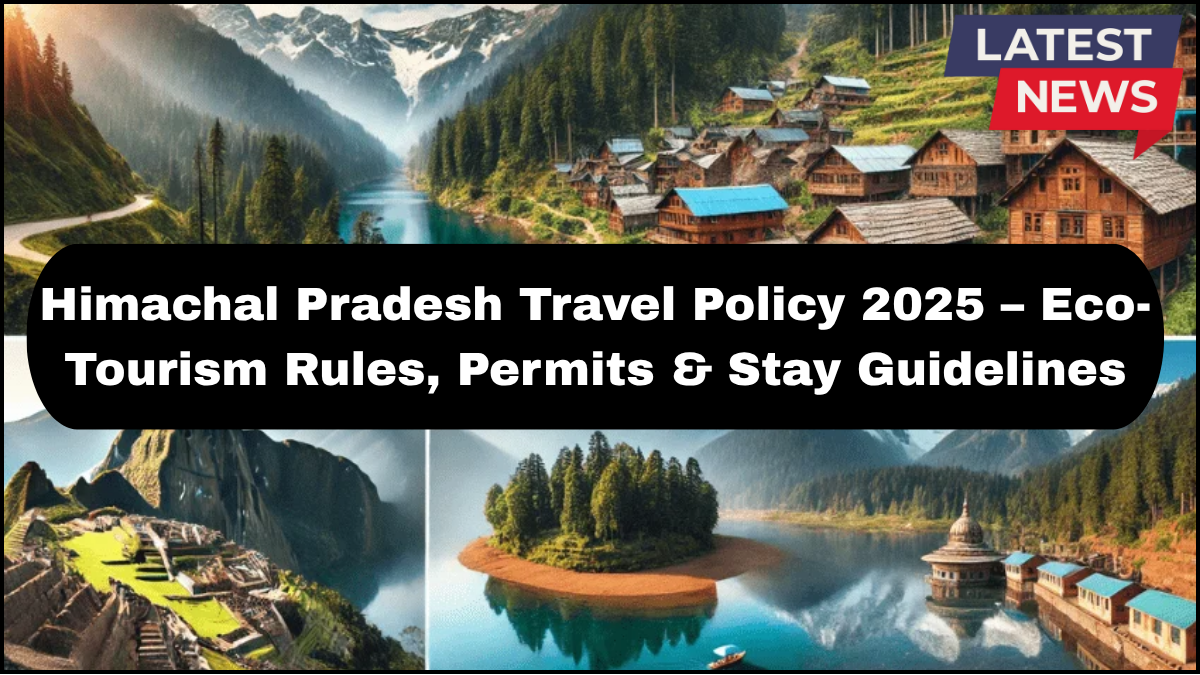The Himachal Pradesh Tourism Policy 2025 introduces a fresh blueprint for sustainable tourism across the state. With a growing influx of travelers, the state government has implemented a forward-looking approach that balances ecological preservation with responsible tourism development.
The new policy emphasizes eco-tourism, regulates permits, and enforces clear stay guidelines to ensure that both visitors and locals benefit without damaging the state’s fragile ecosystems.

What’s New in the Himachal Pradesh Tourism Policy 2025?
The 2025 policy represents a shift in the tourism model from mass tourism to low-impact, responsible travel. Key focus areas include:
-
Promoting sustainable infrastructure
-
Encouraging local community participation
-
Enforcing eco-tourism rules in HP’s ecologically sensitive zones
-
Digitizing the permit process for better oversight
-
Setting clear norms for tourist accommodation and conduct
This policy is aligned with India’s broader environmental goals and is designed to protect the unique biodiversity of the Himalayas while keeping Himachal an attractive destination for conscious travelers.
Eco-Tourism Rules in Himachal Pradesh
Eco-tourism is no longer just a buzzword—it’s now central to how tourism will function in the state.
Protected Zone Regulations
Areas near national parks, wildlife sanctuaries, and alpine meadows are now classified as Eco-Tourism Circuits. Tourists must adhere to specific conduct codes, including:
-
No use of plastic
-
No off-trail hiking or trekking
-
Strict noise pollution limits
-
Group size caps (maximum 10–15 people for guided treks)
Certified Eco-Guides
All treks and adventure activities must now be accompanied by state-certified eco-guides trained in biodiversity conservation, waste management, and first aid. This ensures tourism does not degrade the fragile terrain.
Green Certification for Businesses
Homestays, tour operators, and hotels operating in eco-sensitive zones must obtain a Green Tourism Certification, proving they meet water usage, waste disposal, and energy efficiency benchmarks.
New Permit Rules for Travelers
Under the Himachal Pradesh tourism policy 2025, the permit system has been streamlined to be more efficient and transparent.
Online Permit Portals
A centralized portal now issues digital permits for restricted areas such as Spiti, Rohtang Pass, and certain tribal belts. The system also provides real-time updates on weather conditions and permissible tourist limits.
Dynamic Visitor Caps
To prevent overcrowding, permits are issued based on a dynamic cap system. These limits are determined by daily environmental data, footfall history, and forest department inputs. During peak seasons or ecological alerts, permits may be limited or suspended.
Required Documents
Tourists must upload ID proof, travel itineraries, and proof of bookings at certified accommodations before receiving a permit. For treks above 3,000 meters, health certificates may also be required.
Stay Guidelines for Tourists
To align with eco-tourism goals, the government has laid down a structured set of stay regulations.
Homestays and Local Hosts
The policy encourages travelers to choose registered eco-homestays that follow sustainable practices. These not only reduce environmental impact but also support local livelihoods.
Hotel & Hostel Regulations
Hotels above a certain capacity must maintain wastewater treatment facilities and manage garbage through composting or government-approved disposal systems. Regular audits will determine their compliance and eligibility for renewal of operating licenses.
Tourist Responsibilities
Guests are expected to:
-
Segregate waste at source
-
Avoid loud music or bonfires in forest areas
-
Respect local customs and avoid unauthorized photography of people or religious sites
Violation of these guidelines may lead to fines or revocation of travel permits.
Community Participation and Local Benefits
One of the major shifts in the Himachal Pradesh tourism policy 2025 is its focus on community-led tourism. This includes:
-
Training villagers as trekking guides, naturalists, and homestay hosts
-
Revenue-sharing models for rural tourism clusters
-
Inclusion of local artisans and cuisines in tourism itineraries
This approach ensures that tourism directly contributes to the development of rural Himachal while reducing migration and preserving local heritage.
Technological Integration for Better Management
The tourism department has launched a mobile app that integrates:
-
Permit application
-
Weather updates
-
Eco-zone alerts
-
Emergency services
This digital ecosystem is designed to make tourism both safer and smarter.
FAQs: Himachal Pradesh Travel Policy 2025
What are the main objectives of the Himachal Pradesh Tourism Policy 2025?
The policy focuses on sustainable tourism, environmental conservation, community participation, and improved permit regulation through technology.
Do I need a permit to visit Spiti or Rohtang in 2025?
Yes. Permits are mandatory for visiting restricted or high-altitude areas. These can be obtained online via the state’s official portal.
What qualifies as an eco-tourism activity in Himachal?
Activities such as low-impact trekking, bird-watching, forest walks, camping with minimal footprint, and village stays with local hosts fall under eco-tourism.
Are there penalties for violating eco-tourism rules in HP?
Yes. Tourists found violating waste, noise, or permit guidelines may face monetary fines, cancellation of permits, or even legal action in serious cases.
How can businesses get Green Certification?
Tourism operators must apply through the state tourism board, undergo environmental audits, and comply with sustainability norms to receive certification.
click here to learn more